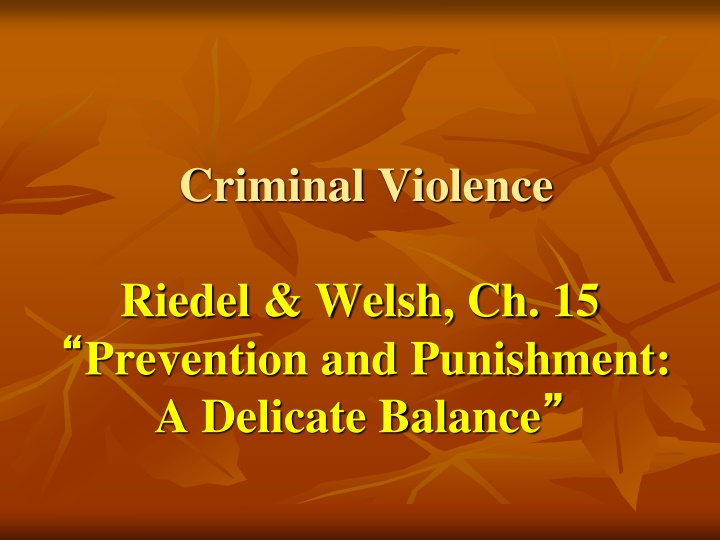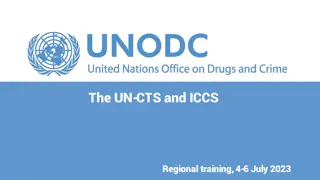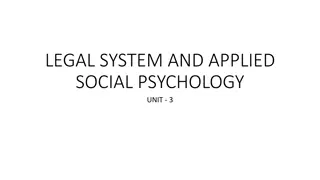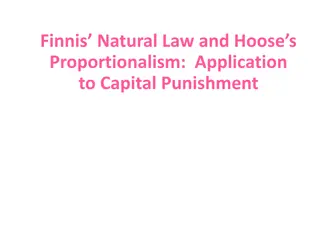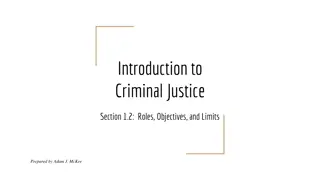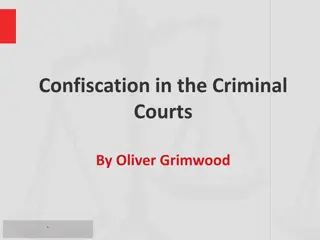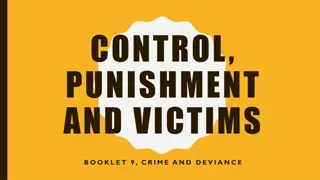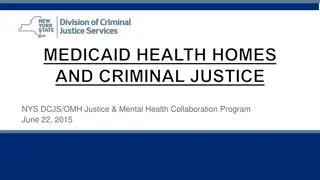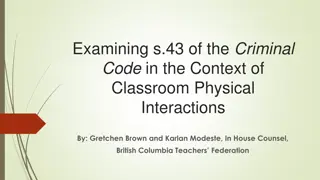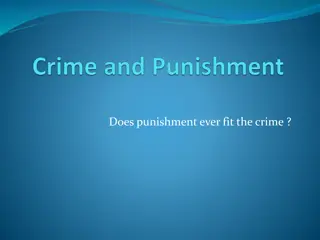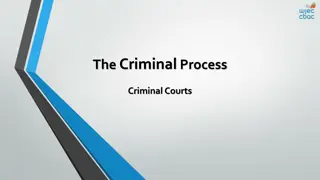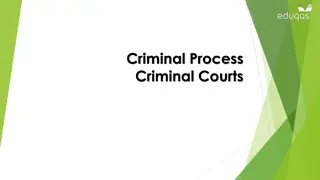Prevention and Punishment in Criminal Justice
This content explores the delicate balance between prevention and punishment in criminal justice, focusing on deterrence, rehabilitation, incapacitation, and restoration. It discusses various approaches, challenges, and evidence-based practices aiming to reduce criminal violence. The effectiveness and limitations of deterrence, rehabilitation, incapacitation, and restoration strategies are analyzed, shedding light on the complexities of addressing crime in society.
Uploaded on Mar 17, 2025 | 0 Views
Download Presentation

Please find below an Image/Link to download the presentation.
The content on the website is provided AS IS for your information and personal use only. It may not be sold, licensed, or shared on other websites without obtaining consent from the author.If you encounter any issues during the download, it is possible that the publisher has removed the file from their server.
You are allowed to download the files provided on this website for personal or commercial use, subject to the condition that they are used lawfully. All files are the property of their respective owners.
The content on the website is provided AS IS for your information and personal use only. It may not be sold, licensed, or shared on other websites without obtaining consent from the author.
E N D
Presentation Transcript
Criminal Violence Riedel & Welsh, Ch. 15 Prevention and Punishment: A Delicate Balance
OUTLINE CJ APPROACHES CJ goals Deterrence Rehabilitation Incapacitation Restoration Examples: Death penalty, three strikes PUBLIC HEALTH APPROACHES Multilevel risk approach Evidence-based practices and programs OJJDP comprehensive strategy Community-based approaches Blueprints for violence prevention
Deterrence General deterrence refers to the inhibiting effect that punishment has on potential offenders in the public. Specific deterrence seeks to prevent future criminal acts only by the individual punished. Evidence: A National Academy of Sciences panel found that studies did not strongly support deterrent effects. Where deterrent effects were found, they were stronger where certainty was increased (probability of arrest and incarceration) rather than severity. Problems: Most research has been based on official statistics (UCR). Many studies are unable to eliminate other factors that could account for observed effects (e.g., biases in measures, regional variations, and other factors that might influence crime rates). Stafford and Warr: Need to examine Both direct and indirect experience with punishment and punishment avoidance
Rehabilitation Rehabilitation refers to any postconviction treatment aimed at reducing an offender's future likelihood of committing crimes. The best studies show that some types of treatment work for some types of offenders, at least some of the time (e.g., Andrews and Bonta) Problems: Evaluation methodologies have often been inadequate, limiting sound conclusions Few programs are available to prisoners (e.g., many want drug treatment but can't get it) Many inmates refuse to participate Inmates are often not allowed to participate for security reasons 1. 2. 3. 4.
Incapacitation Incapacitation: An offender is restrained from committing any further crimes against the public, at least during the period he or she is confined. Selective: Attempts to incapacitate worst offenders (e.g., career criminals) General: Attempts to reduce crime by locking up offenders for as long as possible Evidence: Difficult to evaluate Can t control for many factors that influence crime rates. Some claim that incapacitation effects are evidenced by recent downturns in violent crime. Problems: 1. Selective: We can't predict with any accuracy who is likely to become a career criminal until after he or she has already amassed a lengthy criminal career. 2. General: Would strain criminal justice resources (e.g., overcrowded jails and prisons). Expenses would far exceed available resources.
Restoration Restoration seeks to repair the harm that resulted from the offense. Two broad types of programs: Community justice strategies engage members of the community in the business of solving community crime problems. Restorative justice strategies involve victims as well as offenders in the process of deciding on an appropriate sanction. 1. 2. Evaluation: Strong, consistent results were found for victim satisfaction but not for repeat offending (Sherman and Strang, 2004).
Example 1: Death Penalty Arguments in favor of the death penalty: Public support Deterrence Retribution Cost-effectiveness Arguments against the death penalty: Improper use of state power Racial discrimination The possibility of errors
At year-end 2012, more than 3,000 inmates were held under sentence of death, but only 39 were executed in 2013. The major reason is the lengthy and expensive appeals process required since the US Supreme Court ruling in Gregg v. Georgia (1976). Death sentences must be reviewed by both state and federal courts until the appeals process has been exhausted.
Example 2: Three Strikes Laws The California three strikes law had overwhelming voter support when it was approved in 1994. Following protracted prison overcrowding and state budget crises over the next two decades, California voted in November 2012 to soften the law. The law had targeted offenders previously convicted of at least two violent or serious crimes, such as rape or residential burglary. Proposition 36, supported by about 69% of voters, changed the law so that offenders whose third strikes were relatively minor, such as shoplifting or drug possession, could no longer be sentenced to 25 years to life in prison. Offenders convicted of third strikes for serious or violent crimes under the law can still receive the lengthy prison terms however. About one-third of incarcerated third-strikers (about 3,000 prisoners) convicted of minor third strikes could seek reduced sentences under the new law. Inmates with prior convictions for rape, murder, and child molestation cannot be released under the measure; and courts can reject a request to reduce a sentence if they determine that an individual is a danger to public safety.
PUBLIC HEALTH APPROACHES Multilevel risk approach Evidence-based practices and programs OJJDP comprehensive strategy Blueprints for violence prevention Community-based approaches
MULTILEVEL RISK APPROACH We need to examine the interactions of individual, institutional, social structural, and cultural factors related to violence. According to the National Academy of Sciences Panel on the Understanding and Causes of Violent Behavior We have many promising directions for intervention and prevention to pursue from research findings Better measures and more controlled research (esp. evaluations of promising efforts) are needed to identify causes and opportunities for prevention There are multiple options for intervening and a much greater need for interagency collaboration 1. 2. 3.
Evidence-Based Practices and Programs Identifying evidence-based practices and programs (EBPP) that yield positive client outcomes is an essential step in improving services for adolescents who come in contact with the juvenile justice system. Approaches to implementing EBPP have included guidelines, dissemination of EBPP information, and regulatory policies (e.g., state EBPP requirements for obtaining funding). Example: The Standardized Program Evaluation Protocol (SPEP) translates guidelines for effective juvenile justice programs into practical form. Four Major Principles: Target high-risk cases Use programs that take a therapeutic approach to changing behavior by focusing on constructive personal development Focus on program types that have shown the largest effects in research studies when matching programs to the needs and problem areas of the juveniles served Implement the selected programs well 1. 2. 3. 4.
OJJDP COMPREHENSIVE STRATEGY FOR SERIOUS, VIOLENT, AND CHRONIC JUVENILE OFFENDERS Example 8 Percent Solution (Orange County, California) http://ocgov.com/gov/probation/about/8percent/
OJJDP Comprehensive Strategy: Five Key Objectives Provide immediate intervention and appropriate sanctions and treatment for delinquents (e.g., graduated sanctions) Example: Safe Futures continuum of care for youths and their families (includes human service and juvenile justice systems, health, mental health, child welfare, education, police, probation, courts, and corrections) Prosecute serious, violent, chronic juvenile offenders in criminal court Example: Include waiver and transfer mechanisms that allow serious juvenile offenders to be tried as adults in criminal court Reduce youth involvement with guns, drugs, and gangs Example: Partnerships to Reduce Juvenile Gun Violence attempts to strengthen linkages among community groups, schools, law enforcement, and the juvenile justice system Providing opportunities for children and youth Examples: Mentoring, after-school activities, conflict-resolution training, remedial education, and vocational education Breaking the cycle of violence by addressing youth victimization, abuse, and neglect Example: Safe Kids/Safe Streets strengthens the response of criminal and juvenile justice systems to child abuse and neglect 1. 2. 3. 4. 5.
BLUEPRINTS FOR VIOLENCE PREVENTION A comprehensive effort to provide communities with a set of programs whose effectiveness has been scientifically demonstrated The standards for effectiveness include four criteria: 1. An experimental or quasi-experimental design with random assignment or a matched control group 2. Evidence of a statistically significant deterrent effect on delinquency, drug use, and/or violence 3. Replication in at least one additional site with demonstrated effects 4. Evidence that the deterrent effect was sustained for at least 1 year following treatment http://www.colorado.edu/cspv/blueprints/modelprograms.html
COMMUNITY-BASED APPROACHES Programs located in specific neighborhoods, designed and implemented mainly by nonprofit community groups rather than justice or social service agencies Child and Family Resource Centers: Centers enhanced family functioning at very low cost and reduced delinquency by improving parent child relations and school performance (US GAO). Job-Training Programs: Many of the better job-training programs were successful at reducing crime, improving earnings, and reducing long-term costs Chicago s Operation CeaseFire (now Cure Violence ): This is a collaborative approach that involves a variety of components working together in the community simultaneously, including street intervention, client outreach, clergy involvement, community mobilization, educational campaigns, and policing and prosecution strategies focused on high-risk offenders. http://cureviolence.org/
Conclusion Violence prevention in the United States has a promising but unpredictable future. To the degree that interventions can reasonably balance punishment and prevention and take a rational approach based upon existing and emerging knowledge, that promise may yet be realized. Much further research on risk factors and causes contributing to violence is needed, and more rigorous, valid evaluations of programs and policies are needed. In the absence of such information, untested assumptions and hunches will continue to drive critical policy decisions.
